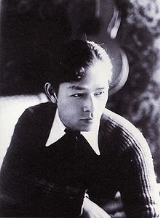
Katsuji Matsumoto
Encyclopedia
was a Japan
ese illustrator
and shōjo manga artist. Matsumoto's 16-page The Mysterious Clover (1934) is recognized as a pioneering work in the field of manga, but he is best known for his shōjo manga Kurukuru Kurumi-chan, serialized from 1938 to 1940, and again from 1949 to 1954.
His illustrations were popular from the 1930s through the 1950s, and he contributed illustrations to numerous popular girls' novels by some of the period's most famous authors, including Yasunari Kawabata
and Nobuko Yoshiya
. He was also a prolific illustrator of children's books and created merchandise for babies, small children, and girls. The Gallery Katsuji Matsumoto in Tokyo is managed by his surviving children.
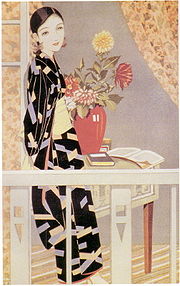 Matsumoto was born in Kobe, the son of Toraji and Ishi Matsumoto, but moved with his family to Tokyo at the age of eight. At the age of 13, he began attending what was then called Rikkyō (St. Paul's) Middle School. Through the introduction of a teacher at Rikkyō, Matsumoto began drawing illustrations for the magazine at the age of 17. Matsumoto withdrew from Rikkyō at the age of 18 and began attending the . During this time he contributed drawings to such magazines as and . It was during this period that Matsumoto was inspired by illustrator Kōji Fukiya to become an illustrator in the field of girls' media. (Matsumoto's younger sister, Ryōko , would eventually marry Fukiya.)
Matsumoto was born in Kobe, the son of Toraji and Ishi Matsumoto, but moved with his family to Tokyo at the age of eight. At the age of 13, he began attending what was then called Rikkyō (St. Paul's) Middle School. Through the introduction of a teacher at Rikkyō, Matsumoto began drawing illustrations for the magazine at the age of 17. Matsumoto withdrew from Rikkyō at the age of 18 and began attending the . During this time he contributed drawings to such magazines as and . It was during this period that Matsumoto was inspired by illustrator Kōji Fukiya to become an illustrator in the field of girls' media. (Matsumoto's younger sister, Ryōko , would eventually marry Fukiya.)
Following the devastation of Tokyo, including its publishing industry, in the 1923 Great Kantō earthquake
, Matsumoto decided to try his fortunes overseas, and managed to obtain free passage to Shanghai
. His hope was to eventually make his way to Paris
. In Shanghai, he earned money by contributing illustrations and articles to the , but when he turned twenty years of age, he was forced to return to Japan to report for the draft. He was rejected for military service because he was flat footed
.
 Matsumoto's first forum for steady work was the magazine , to which he contributed from 1928 to 1938. Matsumoto first ventured into manga in Shōjo Gahō, creating a series of illustrated narratives featuring a lively Chinese girl named Poku-chan, which was irregularly published between November 1930 and March 1934. The Poku-chan strips were drawn in a stylized, almost abstract, Art Deco
Matsumoto's first forum for steady work was the magazine , to which he contributed from 1928 to 1938. Matsumoto first ventured into manga in Shōjo Gahō, creating a series of illustrated narratives featuring a lively Chinese girl named Poku-chan, which was irregularly published between November 1930 and March 1934. The Poku-chan strips were drawn in a stylized, almost abstract, Art Deco
manner.
Matsumoto could draw in a wide range of styles, from the realistic to the near-abstract, but all of his work was distinguished by clean, almost geometrical lines and a strictly Modern
sensibility. While he illustrated numerous dramatic girls' novels, his style was better suited to sunny, playful, or humorous work. In 1935, Matsumoto began to work for the magazine that would become his primary forum, . Shōjo no tomo, with its modern, stylish image, was the ideal magazine for Matsumoto.
In 1932, at the age of 28, Matsumoto was wed to Ayako Nimori . They went on to have seven children (four boys, three girls) together. Because Ayako was an only child, the decision was made to have the firstborn male child legally adopted by her parents
in order to carry on the Nimori name. On official records, therefore, Ki Nimori is listed as the younger brother of Ayako, and therefore the brother-in-law of Matsumoto.Under the Japanese ie family system
that was the law of the land prior to the end of World War II, it was common in cases where there was no male heir for a groom to be legally adopted by his bride's parents and become the successor to her family name. Since Katsuji was himself the eldest son of and successor to the Matsumoto family, this was not an option.
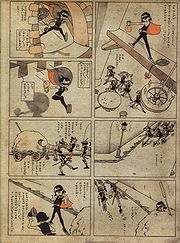 In 1934, Matsumoto drew his first full-fledged manga, a 16-page story titled . Printed as an over-sized pamphlet with a sturdy cardboard cover, and included as a premium in the April issue of Shōjo no tomo, The Mysterious Clover was a variation on The Scarlet Pimpernel
In 1934, Matsumoto drew his first full-fledged manga, a 16-page story titled . Printed as an over-sized pamphlet with a sturdy cardboard cover, and included as a premium in the April issue of Shōjo no tomo, The Mysterious Clover was a variation on The Scarlet Pimpernel
and Zorro
. The protagonist of The Mysterious Clover is a young girl who protects the poor peasants from the cruel and greedy nobles. This work is remarkable for its use of varying angles, including bird's-eye views, and variation in the size of panels. Sakō Shishido , influenced by American newspaper strips, had used similar techniques in his 1930 , but in a far cruder drawing style than Matsumoto's. The Mysterious Clover had been neglected for decades by manga scholars until it was displayed at a 2006 exhibition at the Yayoi Art Museum, where it caught the eye of Fusanosuke Natsume
, who then wrote about it on his blog and in a newspaper column.
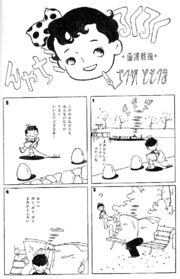 Matsumoto's most famous work is his manga Kurukuru Kurumi-chan ,"Kurukuru"----means "spinning" or "winding", "-chan"----is a diminutive honorific that can be translated as "little" or "dear". which was serialized in Shōjo no tomo from January 1938 until December 1940. Featuring the daily antics of a little girl named Kurumi , each episode was a self-contained story, usually running 4 pages and 22 panels. The strip rarely ventured far from everyday reality, and was characterized by a gradually building absurdity that rarely descended to simple slapstick.
Matsumoto's most famous work is his manga Kurukuru Kurumi-chan ,"Kurukuru"----means "spinning" or "winding", "-chan"----is a diminutive honorific that can be translated as "little" or "dear". which was serialized in Shōjo no tomo from January 1938 until December 1940. Featuring the daily antics of a little girl named Kurumi , each episode was a self-contained story, usually running 4 pages and 22 panels. The strip rarely ventured far from everyday reality, and was characterized by a gradually building absurdity that rarely descended to simple slapstick.
In the earliest episodes, Kurumi-chan is roughly four heads tall
, and would seem to be roughly nine or ten years old. Over the years, though, Kurumi's proportions
changed, until by the 1950s she had become an extremely stylized character no more than two heads high, and of unknown age.
The strip was revived after the war in the magazine Shōjo ("Girl") under the title Kurumi-chan and ran from November 1949 to February 1954.
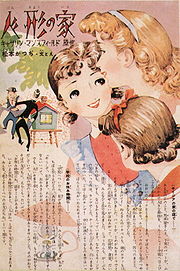 While working on Kurukuru Kurumi-chan, Matsumoto continued to do freestanding illustrations, in both color and black and white, and also to illustrate girls' fiction and poetry. Matsumoto was one of the most popular and influential illustrators working in girls' media, and he continued to be a popular illustrator through the early 1950s. He worked with such prominent Japanese authors and poets as Nobuko Yoshiya
While working on Kurukuru Kurumi-chan, Matsumoto continued to do freestanding illustrations, in both color and black and white, and also to illustrate girls' fiction and poetry. Matsumoto was one of the most popular and influential illustrators working in girls' media, and he continued to be a popular illustrator through the early 1950s. He worked with such prominent Japanese authors and poets as Nobuko Yoshiya
and Yaso Saijō, and adapted many works by non-Japanese author's, including Katherine Mansfield
's short story The Doll's House
, to the short-lived genre of .
Although Matsumoto drew in a wide range of styles, certain features remain consistent. His characters have an air of intelligence without melancholy, and of cheerful optimism that is never saccharine. Other popular illustrators of the day were better suited to the niches in which Matsumoto was not in his element. The multi-talented and enormously popular Jun'ichi Nakahara drew girls who were intelligent and stylish, but humor was not his forte. In the genre of sentimental melodrama, according to Akiko Horiguchi, no one was more popular than Hiroshi Katsuyama (勝山ひろし). But in an age when print media of all kinds were becoming increasingly visual, there was plenty of work to go around.
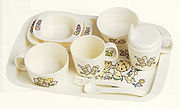 In 1955, Matsumoto abandoned manga altogether. Although he continued to do illustration work in a variety of styles, his focus shifted to the kind of hyper-stylized, wryly adorable character epitomized by the later Kurumi-chan. His target audience accordingly shifted from preteen and low-teen girls to toddlers and young mothers. In addition to illustrating new and original children's books, Matsumoto illustrated numerous classics, including Little Red Riding Hood
In 1955, Matsumoto abandoned manga altogether. Although he continued to do illustration work in a variety of styles, his focus shifted to the kind of hyper-stylized, wryly adorable character epitomized by the later Kurumi-chan. His target audience accordingly shifted from preteen and low-teen girls to toddlers and young mothers. In addition to illustrating new and original children's books, Matsumoto illustrated numerous classics, including Little Red Riding Hood
(1955), Andrew Lang
's Blue Fairy Book (1959, translated by Yasunari Kawabata
), and various other collections of classic Japanese and European fairy tales.
In 1960, Matsumoto founded Katsu Productions , which specialized in illustrations for infants and toddlers and designing various infant merchandise. This merchandise was spectacularly popular. Amateur manga scholar and blogger "lacopen" commented that "When I was a child, [Matsumoto's baby] goods were all the rage, so much so that it is no exaggeration to say they were everywhere." His designs for the infant merchandise company known originally as "Sanshin. Inc." were perhaps the mostly widely consumed and recognized, and it has been suggested that the company changed its name to Combi in response to the popularity of the infant duo, "Haamu" and "Monii" , created by Matsumoto and featured on a wide array of the company's products.
 In 1971, now in his late 60s, Matsumoto built an atelier, in Kamishiraiwa (on the Izu Peninsula
In 1971, now in his late 60s, Matsumoto built an atelier, in Kamishiraiwa (on the Izu Peninsula
, where he turned his creative talents from the modern and cosmopolitan to the traditional and provincial. Using the bamboo that was so plentiful in the area, he designed a variety of toys and objects that could easily be reproduced by the local farmers to sell as souvenirs. For this work, Matsumoto was given a commendation by the Shizuoka Prefectural
government. Although these works seem strikingly at odds with Matsumoto's cosmopolitan image, he in fact had always had an eye for the traditional, and was particularly fond of collecting carefully selected Japanese and Korean pottery and furniture. Modern or traditional, Western or Eastern, the common thread that runs through Matsumoto's aesthetic sense, and his work, is an appreciation of that which is refined, simple, elegant, and unpretentious.
In 1986, Matsumoto suffered the last of a series of strokes, and was hospitalized, never to fully regain consciousness again. The stylish Matsumoto had been famously fastidious throughout his life, and his daughter, Meiko, has written that she was startled to notice that on his hospital bed, where Matsumoto lay unconscious and barely responsive, he had been using his remaining good hand to remove the pills that had formed on the old hospital blanket. Furthermore, although doctors said he had lost his sight, Matsumoto would open his eyes, and, as if looking in a mirror, would straighten the hairs of his mustache with his fingers as he had habitually done for years. Matsumoto died at the age of 81. His cremated remains are interred in the Fuji Cemetery in Gotemba, Shizuoka, at the foot of Mount Fuji
.
and Setsuko Tamura, were his apprentices. Michie, Matsumoto's youngest child, along with several of her siblings and Matsumoto's grandchildren, manages the Gallery Katsuji Matsumoto , soon to be renamed the Katsuji Matsumoto Archives , the official Katsuji Matsumoto website and its on-line shop, and also writes ". The gallery is located at 4-14-18 Tamagawa, Setagaya-ku, Tokyo, 158-0094.
Japan
Japan is an island nation in East Asia. Located in the Pacific Ocean, it lies to the east of the Sea of Japan, China, North Korea, South Korea and Russia, stretching from the Sea of Okhotsk in the north to the East China Sea and Taiwan in the south...
ese illustrator
Illustrator
An Illustrator is a narrative artist who specializes in enhancing writing by providing a visual representation that corresponds to the content of the associated text...
and shōjo manga artist. Matsumoto's 16-page The Mysterious Clover (1934) is recognized as a pioneering work in the field of manga, but he is best known for his shōjo manga Kurukuru Kurumi-chan, serialized from 1938 to 1940, and again from 1949 to 1954.
His illustrations were popular from the 1930s through the 1950s, and he contributed illustrations to numerous popular girls' novels by some of the period's most famous authors, including Yasunari Kawabata
Yasunari Kawabata
was a Japanese short story writer and novelist whose spare, lyrical, subtly-shaded prose works won him the Nobel Prize for Literature in 1968, the first Japanese author to receive the award...
and Nobuko Yoshiya
Nobuko Yoshiya
was a Japanese novelist active in Taishō and Showa period Japan. She was one of modern Japan's most commercially successful and prolific writers, specializing in serialized romance novels and adolescent girls’ fiction, as well as a pioneer in Japanese lesbian literature, including the Class S...
. He was also a prolific illustrator of children's books and created merchandise for babies, small children, and girls. The Gallery Katsuji Matsumoto in Tokyo is managed by his surviving children.
Early life and professional debut

Following the devastation of Tokyo, including its publishing industry, in the 1923 Great Kantō earthquake
1923 Great Kanto earthquake
The struck the Kantō plain on the Japanese main island of Honshū at 11:58:44 am JST on September 1, 1923. Varied accounts hold that the duration of the earthquake was between 4 and 10 minutes...
, Matsumoto decided to try his fortunes overseas, and managed to obtain free passage to Shanghai
Shanghai
Shanghai is the largest city by population in China and the largest city proper in the world. It is one of the four province-level municipalities in the People's Republic of China, with a total population of over 23 million as of 2010...
. His hope was to eventually make his way to Paris
Paris
Paris is the capital and largest city in France, situated on the river Seine, in northern France, at the heart of the Île-de-France region...
. In Shanghai, he earned money by contributing illustrations and articles to the , but when he turned twenty years of age, he was forced to return to Japan to report for the draft. He was rejected for military service because he was flat footed
Flat feet
Flat feet is a formal reference to a medical condition in which the arch of the foot collapses, with the entire sole of the foot coming into complete or near-complete contact with the ground...
.
Early career and marriage

Art Deco
Art deco , or deco, is an eclectic artistic and design style that began in Paris in the 1920s and flourished internationally throughout the 1930s, into the World War II era. The style influenced all areas of design, including architecture and interior design, industrial design, fashion and...
manner.
Matsumoto could draw in a wide range of styles, from the realistic to the near-abstract, but all of his work was distinguished by clean, almost geometrical lines and a strictly Modern
Modernism
Modernism, in its broadest definition, is modern thought, character, or practice. More specifically, the term describes the modernist movement, its set of cultural tendencies and array of associated cultural movements, originally arising from wide-scale and far-reaching changes to Western society...
sensibility. While he illustrated numerous dramatic girls' novels, his style was better suited to sunny, playful, or humorous work. In 1935, Matsumoto began to work for the magazine that would become his primary forum, . Shōjo no tomo, with its modern, stylish image, was the ideal magazine for Matsumoto.
In 1932, at the age of 28, Matsumoto was wed to Ayako Nimori . They went on to have seven children (four boys, three girls) together. Because Ayako was an only child, the decision was made to have the firstborn male child legally adopted by her parents
Mukoyōshi
A is a man who is adopted into a family as a daughter's husband, and who takes the family's surname. This is done to preserve the name and occupation of the family when there is no suitable male heir...
in order to carry on the Nimori name. On official records, therefore, Ki Nimori is listed as the younger brother of Ayako, and therefore the brother-in-law of Matsumoto.Under the Japanese ie family system
Ie (Japanese family system)
The , or "household", was the basic unit of Japanese law until the end of World War II: most civil and criminal matters were considered to involve families rather than individuals . The ie is considered to consist of grandparents, their son and his wife and their children , although even in 1920,...
that was the law of the land prior to the end of World War II, it was common in cases where there was no male heir for a groom to be legally adopted by his bride's parents and become the successor to her family name. Since Katsuji was himself the eldest son of and successor to the Matsumoto family, this was not an option.
The Mysterious Clover

The Scarlet Pimpernel
The Scarlet Pimpernel is a play and adventure novel by Baroness Emmuska Orczy, set during the Reign of Terror following the start of the French Revolution. The story is a precursor to the "disguised superhero" tales such as Zorro and Batman....
and Zorro
Zorro
Zorro is a fictional character created in 1919 by New York-based pulp writer Johnston McCulley. The character has been featured in numerous books, films, television series, and other media....
. The protagonist of The Mysterious Clover is a young girl who protects the poor peasants from the cruel and greedy nobles. This work is remarkable for its use of varying angles, including bird's-eye views, and variation in the size of panels. Sakō Shishido , influenced by American newspaper strips, had used similar techniques in his 1930 , but in a far cruder drawing style than Matsumoto's. The Mysterious Clover had been neglected for decades by manga scholars until it was displayed at a 2006 exhibition at the Yayoi Art Museum, where it caught the eye of Fusanosuke Natsume
Fusanosuke Natsume
is a Japanese columnist, cartoonist. Born in Tokyo to Junichi Natsume, grandson of novelist Natsume Sōseki, he attended Aoyama Gakuin University, which he graduated in 1973. He has written the book , which was illustrated by Fumi Yoshinaga....
, who then wrote about it on his blog and in a newspaper column.
Kurukuru Kurumi-chan

In the earliest episodes, Kurumi-chan is roughly four heads tall
Figure drawing
In art, a figure drawing is a study of the human form in its various shapes and body postures - sitting, standing or even sleeping. It is a study or stylized depiction of the human form, with the line and form of the human figure as the primary objective, rather than the subject person. It is a...
, and would seem to be roughly nine or ten years old. Over the years, though, Kurumi's proportions
Body proportions
While there is significant variation in anatomical proportions between people, there are many references to body proportions that are intended to be canonical, either in art, measurement, or medicine....
changed, until by the 1950s she had become an extremely stylized character no more than two heads high, and of unknown age.
The strip was revived after the war in the magazine Shōjo ("Girl") under the title Kurumi-chan and ran from November 1949 to February 1954.
Book illustrations

Nobuko Yoshiya
was a Japanese novelist active in Taishō and Showa period Japan. She was one of modern Japan's most commercially successful and prolific writers, specializing in serialized romance novels and adolescent girls’ fiction, as well as a pioneer in Japanese lesbian literature, including the Class S...
and Yaso Saijō, and adapted many works by non-Japanese author's, including Katherine Mansfield
Katherine Mansfield
Kathleen Mansfield Beauchamp Murry was a prominent modernist writer of short fiction who was born and brought up in colonial New Zealand and wrote under the pen name of Katherine Mansfield. Mansfield left for Great Britain in 1908 where she encountered Modernist writers such as D.H. Lawrence and...
's short story The Doll's House
The Doll's House (short story)
The Doll's House is a 1922 short story by Katherine Mansfield. It was first published in The Nation and Atheneum on 4 February 1922, and later appeared in The Dove's Nest and Other Stories...
, to the short-lived genre of .
Although Matsumoto drew in a wide range of styles, certain features remain consistent. His characters have an air of intelligence without melancholy, and of cheerful optimism that is never saccharine. Other popular illustrators of the day were better suited to the niches in which Matsumoto was not in his element. The multi-talented and enormously popular Jun'ichi Nakahara drew girls who were intelligent and stylish, but humor was not his forte. In the genre of sentimental melodrama, according to Akiko Horiguchi, no one was more popular than Hiroshi Katsuyama (勝山ひろし). But in an age when print media of all kinds were becoming increasingly visual, there was plenty of work to go around.
Children's books and infant merchandise

Little Red Riding Hood
Little Red Riding Hood, also known as Little Red Cap, is a French fairy tale about a young girl and a Big Bad Wolf. The story has been changed considerably in its history and subject to numerous modern adaptations and readings....
(1955), Andrew Lang
Andrew Lang
Andrew Lang was a Scots poet, novelist, literary critic, and contributor to the field of anthropology. He is best known as a collector of folk and fairy tales. The Andrew Lang lectures at the University of St Andrews are named after him.- Biography :Lang was born in Selkirk...
's Blue Fairy Book (1959, translated by Yasunari Kawabata
Yasunari Kawabata
was a Japanese short story writer and novelist whose spare, lyrical, subtly-shaded prose works won him the Nobel Prize for Literature in 1968, the first Japanese author to receive the award...
), and various other collections of classic Japanese and European fairy tales.
In 1960, Matsumoto founded Katsu Productions , which specialized in illustrations for infants and toddlers and designing various infant merchandise. This merchandise was spectacularly popular. Amateur manga scholar and blogger "lacopen" commented that "When I was a child, [Matsumoto's baby] goods were all the rage, so much so that it is no exaggeration to say they were everywhere." His designs for the infant merchandise company known originally as "Sanshin. Inc." were perhaps the mostly widely consumed and recognized, and it has been suggested that the company changed its name to Combi in response to the popularity of the infant duo, "Haamu" and "Monii" , created by Matsumoto and featured on a wide array of the company's products.
Retirement and death

Izu Peninsula
The is a large mountainous peninsula with deeply indented coasts to the west of Tokyo on the Pacific coast of the island of Honshū, Japan. Formerly the eponymous Izu Province, Izu peninsula is now a part of Shizuoka Prefecture...
, where he turned his creative talents from the modern and cosmopolitan to the traditional and provincial. Using the bamboo that was so plentiful in the area, he designed a variety of toys and objects that could easily be reproduced by the local farmers to sell as souvenirs. For this work, Matsumoto was given a commendation by the Shizuoka Prefectural
Shizuoka Prefecture
is a prefecture of Japan located in the Chūbu region on Honshu island. The capital is the city of Shizuoka.- History :Shizuoka prefecture was formed from the former Tōtōmi, Suruga and Izu provinces.The area was the home of the first Tokugawa Shogun...
government. Although these works seem strikingly at odds with Matsumoto's cosmopolitan image, he in fact had always had an eye for the traditional, and was particularly fond of collecting carefully selected Japanese and Korean pottery and furniture. Modern or traditional, Western or Eastern, the common thread that runs through Matsumoto's aesthetic sense, and his work, is an appreciation of that which is refined, simple, elegant, and unpretentious.
In 1986, Matsumoto suffered the last of a series of strokes, and was hospitalized, never to fully regain consciousness again. The stylish Matsumoto had been famously fastidious throughout his life, and his daughter, Meiko, has written that she was startled to notice that on his hospital bed, where Matsumoto lay unconscious and barely responsive, he had been using his remaining good hand to remove the pills that had formed on the old hospital blanket. Furthermore, although doctors said he had lost his sight, Matsumoto would open his eyes, and, as if looking in a mirror, would straighten the hairs of his mustache with his fingers as he had habitually done for years. Matsumoto died at the age of 81. His cremated remains are interred in the Fuji Cemetery in Gotemba, Shizuoka, at the foot of Mount Fuji
Mount Fuji
is the highest mountain in Japan at . An active stratovolcano that last erupted in 1707–08, Mount Fuji lies about south-west of Tokyo, and can be seen from there on a clear day. Mount Fuji's exceptionally symmetrical cone is a well-known symbol of Japan and it is frequently depicted in art and...
.
Estate
Matsumoto's children, in addition to Ki Nimori, are, in order of birth: Ikki Matsumoto ; Rumi O'Brien ; Motoi Matsumoto ; Ken Matsumoto ; Meiko Matsumoto ; and Michie Utsuhara . Two of the first successful female shōjo manga artists of the postwar period, Toshiko UedaToshiko Ueda
was a Japanese manga artist who helped shape the face of modern shojo manga. She wrote under three pen names: for manga, when writing for newspapers, and later , all three of which are read as Toshiko Ueda in English....
and Setsuko Tamura, were his apprentices. Michie, Matsumoto's youngest child, along with several of her siblings and Matsumoto's grandchildren, manages the Gallery Katsuji Matsumoto , soon to be renamed the Katsuji Matsumoto Archives , the official Katsuji Matsumoto website and its on-line shop, and also writes ". The gallery is located at 4-14-18 Tamagawa, Setagaya-ku, Tokyo, 158-0094.
Further reading
- Shimonaka, Kunihiko (下中邦彦), ed. (1979) , Tokyo: Heibonsha .
External links
- Matsumoto Katsuji no Sekai (松本かつぢの世界, "Katsuji Matsumoto's World"--Official web site maintained by the Matsumoto estate)
- Thorn, MattMatt ThornMatt Thorn is a cultural anthropologist and an Associate Professor in the Department of Manga Production at Kyoto Seika University's Faculty of Manga in Japan. He is most well known in North America for his work dealing with shōjo manga. He has appeared at multiple anime conventions, including...
(2006) "Pre-World War II Shōjo Manga and Illustrations" matt-thorn.com

